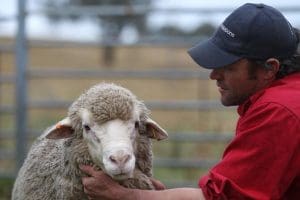
NSW Merino breeder Chad Taylor.
A MOVE to double shearing combined with a balanced breeding program has generated extra profit from maiden ewes for New South Wales breeder Chad Taylor.
Merino ewes from his Mumblebone flock cut 3-3.5kg of 18.5 micron wool in six months with 130 per cent lambs at foot.
Mr Taylor, of Wellington, NSW, said staple length was critical to attract good competition for the wool in that six-month period.
“Shearing instead of crutching is an easy process to step into.
“If we have to go to an eight month cycle to get length of staple, then there is also a crutch required in that time, which becomes cost prohibitive,’’ he said.
“In round figures, it costs us $2 to crutch and $7 to shear, which means we need to make up the $5 per head difference to justify the exercise.
“One of the big benefits of six month shearing is that the sheep grow an extra 10 percent of wool,” he said.
“That extra wool, at current prices, gives us an additional $7 per head, which more than covers the extra cost of shearing.’’
Click here to get the latest Sheep Central story links sent to your email inbox.
Double, or six-monthly shearing, will be a topic on the program at the Mumblebone spring field day on September 19. Fox & Lillie Rural branch manager Jenni Turner, of Culcairn, said management benefits of bi-annual shearing included increased joining percentages and body condition scores.
Ms Turner said the 50-70mm length wools were used to manufacture knitwear.
“Six or eight monthly shearing does require good communication and planning.’’
Ms Turner will be among the guest speakers at the September 19 field day. Industry speakers include Russ Davis, Ceva Animal Health, Dr Mark Ferguson, New Zealand Merino Co, and Hannah Marriott, Nuffield scholar.
The field day will run from 10am to 4pm, with lunch provided, at 456 Wuuluman Road, Wellington, NSW.
“Speakers will be covering a lot of sheep science topics from semen quality, reproduction, carcase traits, six monthly shearing, and making data collection profitable for commercial operations,’’ Mr Taylor said.
Mr Davis will discuss semen quality, the seasonal nature of sheep breeding and the options available for management, while Dr Ferguson will speak on muscle and fat in the balanced Merino.
Individual animal performance and identifying the top performers will be the topic for Ms Marriott.
As a breeder, Mr Taylor said it was important not to fall into the trap of narrow selection but have strong, balanced traits across the board.
“As a wool producer I used to focus heavily on fleece weight and micron, resulting in sheep that under-performed in growth and reproduction.
“We now select for total productivity which includes these wool traits along with growth, carcass and lamb production,’’ he said.
Mr Taylor said ewes that conceive and lose a lamb within a few days of birth also lose 10pc of their wool cut to produce a lamb that dies.
“The loss in fleece weight rises to 20pc if the lamb dies sometime after weaning,’ he said.
“This makes lamb and weaner survival important for any breeder who places a high priority on wool cut,’’ he said.
“We don’t want to lose either the foetus or wool production.
“Condition score, selected through muscle and fat, are key traits to have in the mix to allow ewes to maintain their energy levels during pregnancy and lactation,” Mr Taylor said.
“With better condition comes better production, particularly when under pressure.’’

I hope Ms Marriott includes the figures for the repeatabilities of the traits she might comment on.